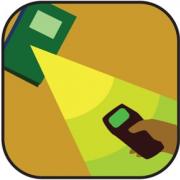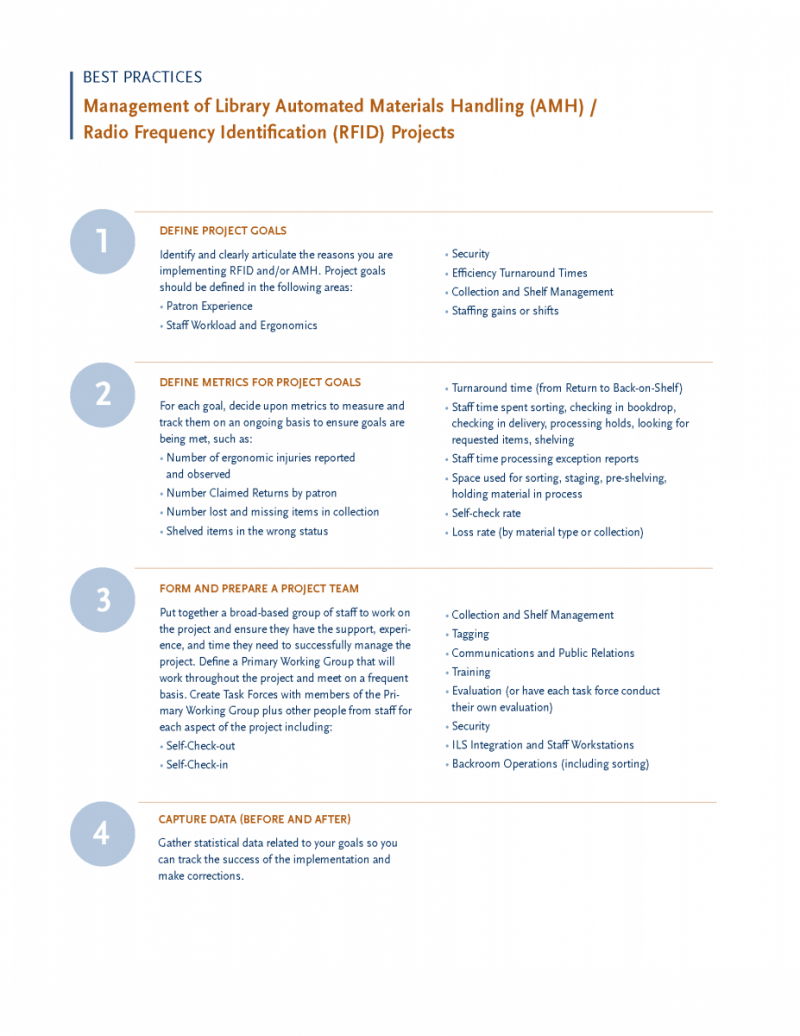You are here
RFID
Radio Frequency Identification (RFID) systems are a technology many libraries use to make materials handling more efficient and to reduce staff workload. If you've never heard of RFID, you may want to start with our RFID Primer which provides a thorough introduction to RFID use in a library context.
While RFID technology has been available for a decades, it has only been used in libraries for the last 10 years or so. The slow uptake in libraries has been because of cost of the technology, concerns about privacy, and the lack of standards.
However, as of March, 2012, NISO finalized a set of recommendations (NISO RP-6-2012) that give libraries what they need to ensure some level of interoperability across RFID implementations in the U.S. If the guidelines are followed, libraries need not be locked into a single RFID vendor's solution and tags from one library can be read by other libraries (and security can be turned on and off as items move across resource-sharing systems).
The data model defined by RP-6-2012 which ensures interoperability between vendors also adds new functionality that is important for libraries to use. The data model provides for 26 fields that can be written to the RFID tag. Most libraries use only one to three of those fields including the Unique Identifier (barcode number of item), Owner Institution, and Set Info. Owner Institution simply identifies the library or library system that owns the item. It is useful because it, in combinatio with the Unique Identifier, allows the library to uniquely identify that item outside of the library system.
Set Info is a very important field that too many libraries fail to utilize. It allows the library to identify sets that can be verified by self-check machines and sorters thereby reducing the handling of certain media items. For example, a single disc DVD can be encoded as part of a two tag set (meaning two RFID items are encoded as a set). One tag is on the case and one on the DVD. When encoded as a set of RFID tags, the self-service equipment or AMH (automated materials handling) system can be configured to verify that all tags that are part of a set are present at check-in, check-out, or during sorting.
Going forward, there are many more possibilities for leveraging those 26 other fields on the RFID tag but libraries are constrained by the communications that are possible with the integrated library systems (ILS) and library service platforms (LSP). However, as the various ILSs and LSPs expand their use of application programming interfaces (APIs), there will be more opportunities for creative applications using RFID.
However, while APIs are a good thing insofar as they increase the opportunities for communicating with the library system and using the data stored there, each API is a proprietary set of code that RFID vendors must write to. In other words, if an RFID vendor developed a fabulous new product that required accessing something in the ILS that could only be accessed via the API (e.g. it wasn't one of the standard SIP messages), the the RFID vendor would have to spend a lot more money developing that solution because it would require custom integration with each ILS.
Because of this concern, the RFID vendors have led an effort to develop a set of library interoperability standards framework for defining that communication while standardizing on a set of principles, variables and data values. This framework is called the Library Communication Framework (LCF). It is in every library's interest to require their ILS, LSP, and RFID vendot to join the LCF Consortium and commit to developing new products using that set of principles, variables, and values so that libraries can benefit from new RFID products that are affordable and more easily supported by the RFID vendors. More info is available on the Library Communicaiton Framework at https://bic.org.uk.
If you are thinking about procuring an RFID system, get current on NISO RP-6-2012 standard, learn about how to use the Set Info field, and learn about the LCF. Then, choose vendors that support these standards and can support you in doing what you want to do with RFID.
Projects and Presentations
| Date | |
|---|---|
|
Client: |
2022 - current |
|
Client: |
2015-2020 |
|
Client: |
2021 - |
|
Client: |
2021 - 2022 |
|
Client: |
20182017-2018 |
|
Client: |
20172016-2017 |
|
Project: Client: |
20172015-2017 |
|
Publication-Presentation: Event/ Publication: Strategic Library Webinar, April 27, 2016 |
2016 |
| 20162015-2016 | |
|
Client: |
20152014-2015 |


